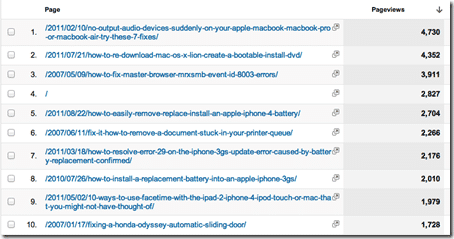I have often been asked: why the heck do you have those automated tweets of old content coming from your blog? What is the reasoning? They are outdated and might not be topical, could be viewed as out of context and, in my case, might be talking about technology, products or services that are over a year old.
Think about it, you pour you heart into every article you write and you want to have the world consume and hopefully enjoy your content. So, you write it and post it and then move on to the next piece of juicy content. You do this every day/week/month and over the years, you amass quite a nice set of articles. But who really goes through your site and hits the “previous article” button? It doesn’t happen that frequently. And if they do, it is probably for just a few articles. Or, people browse within a category to see your thoughts and ideas about a certain subject matter. But for the most part, once your content is there, it gets buried and lost in the archives.
Of course, search engines are your friends, so assuming that your articles have good SEO (Search Engine Optimization), have included good keywords, descriptions and have a catchy title, you could get visitors to your old content simply by the means of searches. For example, if I look at my Google Analytics for the past 30 days, some of my top content is pretty darn old:
3 of the top 10 are from 2007, 1 is from 2010, and the rest, apart from the home page are from 2011. There is a commonality of the older posts, at least for me – they are all “How To’s” which do extremely well when it comes to SEO.
So, with search engines doing such a great job, why would you want to have your social media engines repurpose older content? The answer is right in that same question – “social media.” When I first started writing, social media didn’t exist. You posted your content and hoped that people would eventually come to it or that they had subscribed to your RSS feed. But, as Twitter and Facebook emerged as powerful tools to socialize your content, suddenly there was a new way to get your writing out to new eyeballs quickly and reach new audiences.
The thing about social media is, it is a living and breathing organism. Hopefully, your followers are growing as you share your thoughts and ideas within those mediums. As your social reach grows, your older content may become more relevant to these new members of your “social team.” Sure, they can go back and see other articles that you have written but seriously, who has the time to do that. I, and probably many others, suffer from a term that I’m coining called “Technology Attention Deficit Disorder” (TADD) where people are getting distracted by the next best bright and shiny gadget or application.
Because many people like me seem to suffer from TADD, sometimes you only have seconds to get your content in front of them. To really do social media right, you have to be on it all the time, interacting with your peers, friends or followers. It’s a full time job and unfortunately, I don’t have time to individually seek out people to share specific content to. There may be a relevant article for a particular conversation and I will take the time to search out an article to share it directly with an individual.
But many times, you don’t have time, so you need to figure out other ways to socialize your content. Sometimes, you may want to do that in an automated fashion. There are advantages and disadvantages to automating this process, and this is probably a subject for another article, but at a high level, the disadvantages are some of the ones that I mentioned in the first paragraph: content being out of context, article not being relevant, or, in my case, the news or story is simply “old”.
I weighed these issues when for a while before I decided to set up automation for socializing my old content (and there are a few people who still do not see the value – I appreciate that but hopefully my reasoning will move their opinion, if only a little bit). For starters, I run a WordPress blog so there are an abundance of extremely useful tools to get your content out to the social web. In this particular case, I’m using a plugin called: Tweet Old Post. The plugin has some interesting features:
- Randomly picks an older post
- Allows you to specific the interval between tweets
- Lets you specify the minimum and maximum age of the content that you want to tweet
- Allows you to exclude certain categories
- Lets you assign a hashtag to those older post tweets
So, in my case, I set the range for the age to be between current posts and with a maximum age of 1 year and I make sure that I only tweet out periodically (e.g., one time a day). Also, so that it is crystal clear, I put a hashtag of “#OLDpost” on the tweet automatically so that people know that it is exactly that, an older piece of content.
Enough about the technology behind this. If you have read this far, you probably want to know why I’m doing it. Much of it was covered in the paragraphs above so I will recap it:
- Exposure of your content to new social followers – as your social networks grow, some of your newer members may actually enjoy some of your older content.
- Move non-SEO heavy content out to the social web – as I mentioned earlier, some of my most popular topics revolve around How-to’s or Fix-it posts. These do really well with search engines. But for those non-optimized pages of not-as-popular content, tweeting out an “old post” here and there will help boost that page’s visibility on the social web and may get picked up elsewhere, thus giving it new legs.
- Give older content new legs & new conversations – you would be surprised how many people actually retweet my “old post” tweets and then thank me for providing the information. When you first post, you might not have that much engagement, but later, more people might know about the product, service or subject and may actually have something to say about it.
- Increase your site’s page views – the more views your site has, the better, especially if you are running advertising or looking for sponsorships.
- People need your message pounded into their heads over and over again – it’s a known fact that in order for a message to be heard, it frequently needs to be repeated. Think of these “old post” tweets as a way to do this. Just be sure that you don’t have the same article go out too frequently!
It’s important not to over-saturate your social streams with “old content” and be sure that you are regularly sharing new, pertinent and relevant new content. The WordPress plugin that I mentioned does a pretty good job at allowing you to restrict what is sent, how frequently and when so be sure that you apply those settings carefully.
In the end, the choice is up to you. While I have found that this type of automated old content push works for me, it might not work for you. There are other intelligent plugins that can do powerful things with your old content on your blog, like a “related posts” plugin that presents a list of articles that have similar content or keywords to the one that a reader is viewing currently. I use YARPP (Yet Another Related Post Plugin) which is not only powerful but really works as well.
What are your thoughts? Is promoting your older content important to you? And if so, how are you doing it? Leave me a note and let me know what you do or don’t do.
HTD says: Your content is king so give it a boost every once and a while by re-introducing it.







2 comments
Peter Kretzman
Michael, this is a thoughtful, even-handed, and solid post, and I appreciate that you acknowledge that the approach you advocate won’t work for everyone.
I am one of those people for whom it doesn’t work. :)
This practice first crossed my radar a couple of months ago. A long-time, highly respected CIO blogger started retweeting his old posts, at the rate of one per day. There was no obvious indication that it was old content, unless one looked carefully at the date. In this case, the practice came with some additional unattractive aspects, such as failure to approve new comments that people left on the old posts. So while the point may have been to engage, it fell flat when there wasn’t the necessary follow-up. I had a side discussion at the time with a fellow tweep who was similarly confused and irritated by these tweets of old material. Equally, I’ve been highly annoyed at times when I’ve clicked through on this guy’s tweeted link, only to discover it’s a post that I already read, ages ago. Surfing time is short, and this practice seems disrespectful of one’s regular readers. I’ve slowed down on clicking through on his posts as a natural result of finding out that I’m wasting my time. I also have no good way of really telling whether the writer’s thinking has evolved in the (potentially) years since the post; not everyone goes back to their old posts and puts in forward pointers to related or revised material.
I agree with you that a blogger can mitigate these effects to some degree by clearly marking the post as old, and by conducting better follow-up.
Nonetheless, I tend to reject just about ALL automation in the Twitter universe, whether it’s auto-follow or auto-post or even auto-scheduling. It’s trying too hard. It’s often annoying to the reader, at least to THIS reader. It feels like a kind of gaming the system, all for the sake of the almighty clickthrough. I’m on Twitter mainly so I can keep abreast of current developments, and I think that’s true of a lot of people; we can surf on our own to find historical posts. Technology evolves rapidly, and a post covering (for example) best practices from several years ago is not only confusing but may actually be more damaging than it is helpful. As is the case with you, good SEO practices tend to drive a lot of readers to my older blog posts anyway (my most popular post typically each week is still one I wrote five years ago), but at least there, it’s not being presented (implicitly) as new content. Newly flogging old content reeks to me a tiny bit of desperation, even though I’m of course proud of all my old posts.
I do repost my own material from time to time, but always in the context of a current discussion, and only after determining that I think it’s a relevant contribution to that discussion. I’ve yet to see any algorithmic way of figuring that out reliably. Like any author, I love to have my posts get readership, but I’m unwilling to try so hard for it that I annoy people.
hightechdad
Hi Peter,
Thanks for taking time for such a comprehensive reply. I appreciate your opinion and your insights. The scenario that you point out is a good one actually and part of the reason why it is critical to clearly say that it is an “old post” via a hashtag. There are obvious ways, that you mention, to include your older content within newer content via linking to the older content. I too absolutely hate when twitter bots send out links to really old content. You feel deceived and that you have wasted your time.
And I agree wholeheartedly with you regarding automation of DMs when you follow someone. I tried that for a while (many years ago) and then realized that I absolutely hated it and promptly removed it.
I believe that if you DO decide to automate the tweeting of old content that you set pretty tight windows. The world that I work in (technology) has compressed timeframes which means that even though I limit my old tweets to 1 year or newer, some of those feel ancient! Not to pimp this plugin but there are some nice configuration items to ensure that you aren’t posting the same article over and over.
And, here’s a thought, there might be some of your content that is timeless so with those, you could potentially set a category of
“timeless” and then have the plugin ONLY tweet those articles. Just an idea.
The funny thing is, I crank out so many articles, sometimes I actually
forget what I have written (I guess I’m getting old). So the occasional
reminder his helpful just for me (haha).
Again, possibly more relevant is the automation around “related posts”
which aren’t tweeted out but I definitely believe add value to any
article. If there were some way (marketing people pay attention) to
track what content someone clicks on via twitter and then actually tweet
back to those people other related articles, now THAT would be cool!
Think of it like a Twitter Drip campaign or something like that.
Thanks again for your comments!